Commander is far and away the most popular format in Magic: the Gathering. Unfortunately, this format is also notorious for being expensive to play. Decks consist of 100 cards, and aside from basic lands, all these cards need to be different.
This demands creativity from Commander players who are forced to dig for numerous cards with differing names – even if they all accomplish the same purpose. Ramping becomes increasingly challenging with these restrictions in place, but it doesn’t have to be impossible or super costly.
In this guide, we’re going to show you the best affordable ramp for Commander. None of the cards in this list will break the bank, allowing you to build viable ramp for an affordable price.
What Does Ramp Mean in Magic: the Gathering?
Ramp refers to cards that accelerate your mana usage beyond the typical one land per turn, allowing you to play higher cost spells sooner, multiple spells in one turn, or activated abilities in addition to spells.
Some of the most monetarily expensive cards in Magic are ramp cards, including the infamous Black Lotus. This is because mana is such an integral part of the game; more mana = playing more cards = winning faster.
Ramp in Commander doesn’t have to be expensive though. Many staple ramp cards in the format have been reprinted enough that prices are generally pretty reasonable. Additionally, there are so many cards in Magic that you can often uncover some hidden gems by doing some digging yourself.
When considering ramp options for Commander, the general rule is to stay at or under a mana value of two when possible. This allows you to accelerate your mana as fast as possible during the early game, giving you a solid foundation to become a threat in the mid to late game.
Ramp with a mana value of three or above is generally considered too slow for finely-tuned decks unless it’s extremely efficient or offers additional desirable effects. This ramp is often much more affordable than its two mana counterparts though, so if building on a highly constrained budget, or playing in a lower power playgroup, it’s definitely worth considering.
Best Affordable Ramp Cards for Commander/EDH
Many of the cards we chose require a commander with green in its color identity, which makes sense: green is the color of mana focused on mana generation.
We also want to mention that our definition of “affordable” is anything that costs under $5 USD at the time of writing this article. However, price is subject to change, and the costs for the cards we chose are likely to either increase or decrease with time. It is entirely possible, then, that the cards we picked for this article may no longer fit our definition of “affordable” at the time you’re reading this.
Sol Ring
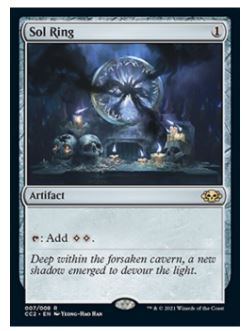
Sol Ring has long been considered a staple in Commander, meaning it should be in just about every single EDH deck you make. The dream starting hand includes Sol Ring; it’s only one mana, and it immediately triples your mana output – provided you have things you can use that colorless mana on.
Additionally, it tends to be quite affordable because of its ubiquity. Constant reprints keep its price relatively low.
Arcane Signet
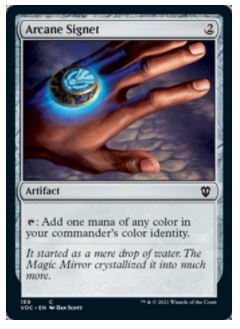
This was a card specifically made for Commander. Arcane Signet’s ability – tapping for a single mana – only works when you’re playing EDH, since it generates one mana of a color in your Commander’s color identity. If you’re playing with a five-color Commander, this means it can tap for any color.
Like Sol Ring, Arcane Signet is reprinted regularly. As a result, it maintains a generally accessible price that earns it a place in countless EDH decks.
Fellwar Stone
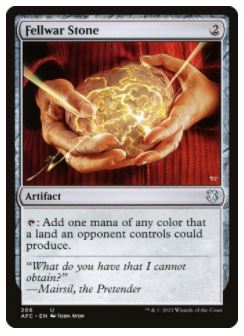
Commander/EDH tends to be a format played with multiple people at the table, as opposed to one-on-ones (although it isn’t unheard of to play it against a single opponent, either). Fellwar Stone is more useful the more players you’re up against; it’s likelier, then, that multiple opponents will be using lands that tap for at least some of the colors you need.
An interesting quirk to note here is that Fellwar Stone cannot be tapped for mana if your opponents are only using lands that produce colorless mana. This isn’t likely to happen, however, so it’s probably not something you need to worry about.
Wayfarer’s Bauble
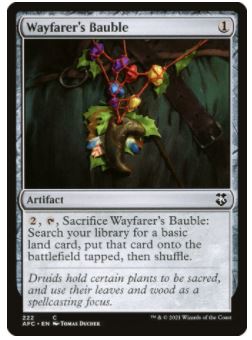
Historically, green has been the best color in Magic for ramping into absurd amounts of mana. With Wayfarer’s Bauble, though, you can enjoy a ramp effect that’s typically reserved for green – the ability to search your library for a basic land and put it onto the battlefield.
Also like Sol Ring, it’s amazingly useful to have in your first hand. You can cast it on turn one, then tap and sacrifice it on turn two to ensure you have three mana, putting you ahead of the curve.
Sakura-Tribe Elder
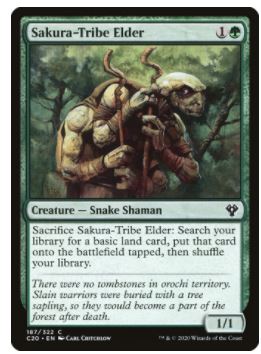
With Sakura-Tribe Elder, you get some classic green ramp on legs. It’s a versatile card that you can use as a chump blocker, or you can use its instant-speed sacrifice ability to grab a basic land card from your library. Because its sacrifice is instant-speed, it’s also effectively immune to removal; if someone attempts to target it, you can just sacrifice it instead.
What’s more, the ability to sacrifice it any time makes it a great fit in landfall decks. You can use it to trigger a landfall keyword on another card.
Farseek
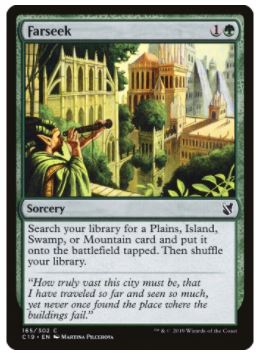
At first glance, Farseek looks like a more limited Rampant Growth, since it can’t fetch you a Forest. However, take another look and you’ll see that Farseek is actually more powerful. It can fetch any land with the Plains, Island, Swamp, or Mountain type, which means you can grab Kaldheim taplands, Ikoria triomes, shocklands, or even those ultra-expensive original dual lands.
Cultivate
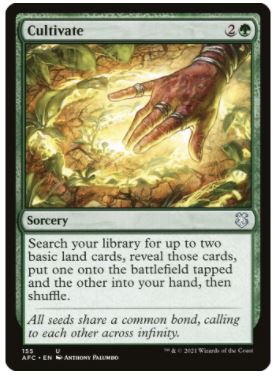
Both Cultivate and Kodama’s Reach are similar ramp cards that deserve a spot on this list. They may appear costly at three mana, but they’re still powerful since they ramp you and guarantee you a land drop both this turn and your next turn.
Furthermore, since they don’t specify which type of land you can get (other than it being basic, anyway), you can use them for a little mana-fixing to find any colors you may be lacking.
Signets
We couldn’t pick just one signet, so we’re including all of them here. To be clear, by “signets,” we are referring to all the guild signets, which consist of the following:
- Azorius Signet
- Boros Signet
- Dimir Signet
- Golgari Signet
- Gruul Signet
- Izzet Signet
- Orzhov Signet
- Rakdos Signet
- Selesnya Signet
- Simic Signet
All the signets are excellent when it comes to mana-fixing. You get a net gain of one colored mana – although it’s worth mentioning that you also need to put one mana into it in order to tap it.
It’s also important to mention that signets are generally more effective in decks that are running fewer colors. This is because each one only generates two colors. You’ll need to look for more flexible ramp cards if you’re building, say, a five-color deck.
Prices vary for signets based on the color combinations of the one you choose.
Roiling Regrowth
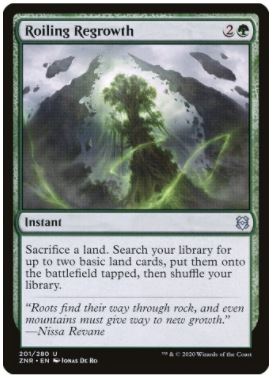
In many ways, Roiling Regrowth is similar to Cultivate. It’s green, three mana, and allows for fixing mana, since you can search for any two basic land cards with it.
Since it requires you to sacrifice a land, it also has some usefulness in decks that care about lands in graveyards. An example of a deck that focuses on putting lands in graveyards would be a Gitrog Monster deck. (Keep in mind that, prior to sacrificing the land, you can also still tap it for mana – it’s not a totally useless sacrifice.)
Another benefit to Roiling Regrowth is that it’s instant-speed. You can save your mana if you’re worried about affording a response to a threat, then ramp if the threat doesn’t occur that turn.
If someone counters Roiling Regrowth, you also don’t have to sacrifice the land any longer. The land sacrifice is one of the spell’s effects – unlike with Harrow, which otherwise functions similarly to Roiling Regrowth.
Mind Stone
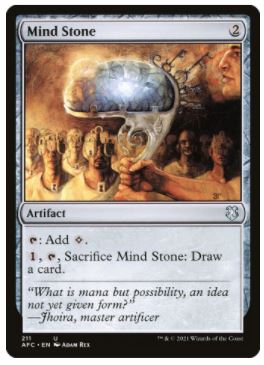
Mind Stone is a solid, basic, two-mana ramp card. It’s not quite as good as the options previously mentioned on this list, as it produces only one colorless mana. That’s why we’re putting it in tenth place.
However, we felt it still deserves a spot on this list. Not only is it affordable, but it gives you the option to sacrifice it for card draw. Once you’re comfortable with the amount of mana you have available, or if you find yourself in desperate need of an answer, you can use it to draw a card.
Honorable Mentions
Some cards are great for ramping and low in monetary cost, but just narrowly didn’t make the cut for our above list for whatever reason. We still want to mention some of them to ensure you have options, so we’re going to put them in their own separate honorable mentions section here.
Llanowar Elves (and Variants)
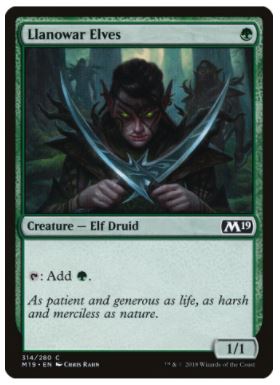
Llanowar Elves (and other similar cards, such as Avacyn’s Pilgrim and Elves of Deep Shadow) are worthy of mention in any collection of affordable ramp cards. Their general idea is the same: a low cost creature with low stats and an activated ability that produces mana.
Their low stats make them innocuous in combat, and their status as a creature leaves them particularly vulnerable to removal. However, if they’re left untouched, they’re generally very efficient at ramping.
Rampant Growth
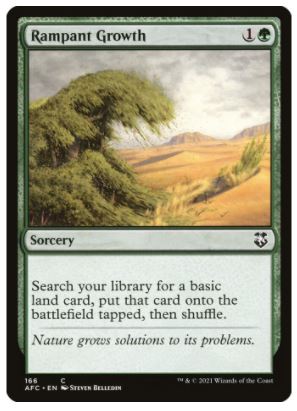
Modern problems require…natural solutions. If that’s what you’re looking for, consider Rampant Growth, which is one of the most straightforward ramp spells currently in Magic existence. It’s two mana for one basic land at sorcery-speed.
Personally, we consider Sakura-Tribe Elder to be superior to Rampant Growth, which is why it’s in the Honorable Mentions section instead. However, Rampant Growth is typically cheaper, so your opinion may differ from ours here.
Dark Ritual
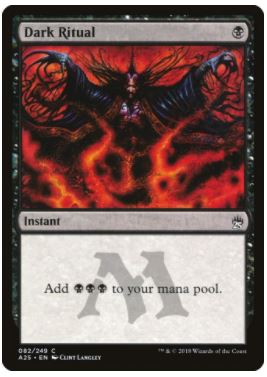
Black does a little bit of everything in the color pie, but usually at a price. That’s what makes Dark Ritual good; it’s a powerful one-turn-only ramp card that doesn’t come with the typical “bargain with the devil price” thematic to black mana. When you cast it, you get a net gain of two black mana for a single turn.
Dark Ritual is particularly strong in the early game. It’s during earlier phases that playing three-cost cards is most effective, dramatically shifting the balance of power.
One thing to keep in mind here is that its heavy black mana values mean you need to carefully consider the color weights of your mana curve before adding it to a deck. In mono-black decks, it’s a no-brainer – you’ll always have need for black mana. In multi-color decks, however, it loses some of its value.
Prismatic Lens
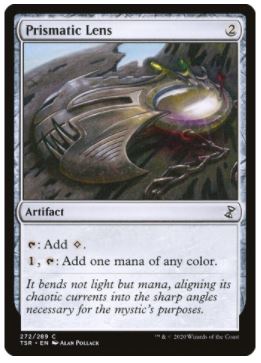
If you’re unable to get your hands on Mind Stone, Prismatic Lens is a viable alternative. It’s basically the same: a simple two-mana ramp card.
As an added benefit, it tends to be cheaper than Mind Stone, too, making it a more reasonable expenditure. However, its weakness is that it lacks the ability to replace itself and its filter effect is technically a net loss of one mana, since you lose the mana you’d gain from its first ability.
Talismans
This particular honorable mention is a lot like the signets we discussed earlier; there are numerous talisman cards, and we couldn’t pick just one here. Talismans are similar to signets in that they’re both two-cost mana rocks tied to two colors.
Unlike signets, they don’t require the same mana input, instead tapping for either a colorless mana or a mana of one of its two colors in exchange for it dealing one damage to you. Like signets, though, their price varies wildly depending on the color combination.
Corrupted Grafstone
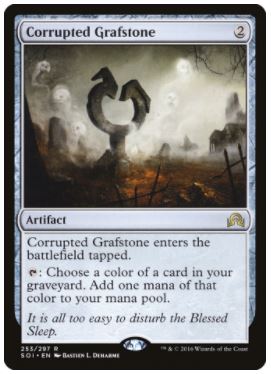
The flaws with Corrupted Grafstone are obvious, so it’s easy to see why it’s an honorable mention rather than one of our top ten. It enters the battlefield tapped and requires a colored card in your graveyard to add mana at all. Unfortunately, colorless cards in your graveyard won’t add colorless mana, so it’s a bit harder to make Corrupted Grafstone work.
Frankly, it’s unlikely to actually ramp you on turn three if you played it on turn two unless you’re running a lot of cheap instants and sorceries, aristocrats, or self-mill. But if you’re in dire need of affordable ramp, Corrupted Grafstone is fairly cheap, and the potential for colored mana from a two-cost artifact makes it an intriguing choice for ambitious, budget-conscious deck builders.
Bucknard’s Everfull Purse
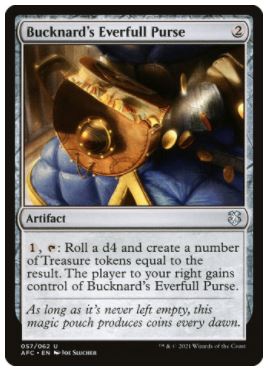
If you’re a fan of tabletop RPGs, you may appreciate the die-rolling mechanic that Bucknard’s Everfull Purse incorporates. The problem with this mechanic, as you can imagine, is that it’s completely random. Sure, if you manage to roll a four, it’s quite efficient…but if you roll a one, Bucknard’s Everfull Purse merely replaces its activation cost.
Additionally, the card moves to the player on your right after you activate it. There’s no guarantee it’ll actually make it back to you, and even if it does, you’re waiting a minimum of X turns before you get to use it again (where X is the number of opponents you have).
In our opinion, one of the best uses for it is in a group hug deck. Otherwise, it could be a fun choice if you’re simply feeling lucky.
Conclusion
Magic: the Gathering has a reputation for being a needlessly expensive hobby, and as time goes on, this reputation is only becoming more and more deserved. Building decks – especially Commander decks, which require you to only use one copy of each card (aside from basic lands) – can be a costly endeavor.
With a little creativity, however, even the price of building a Commander deck from scratch can be drastically reduced. Ramp is vital in the format, so knowing where to get reasonably priced ramp cards is a skill. If you need more help building your deck, you can also check out our in-depth guide on how to build a Commander deck for under $20.
